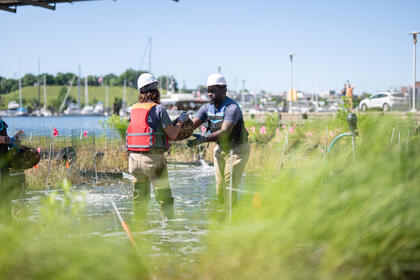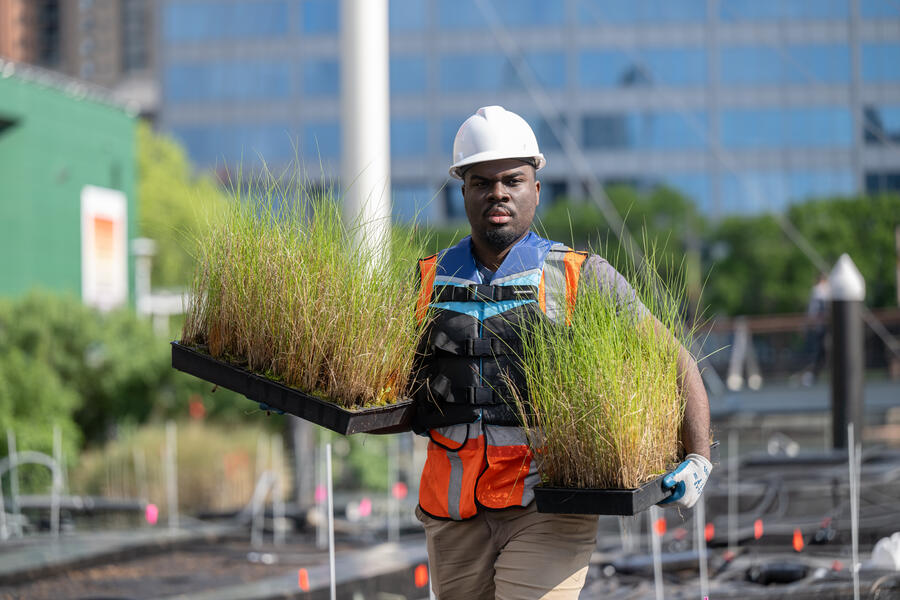Hundreds of years ago, Baltimore's Inner Harbor had no ships, no piers, no electric scooters collecting barnacles in the water's murky depths. The water wasn't deep enough to lose objects in, let alone swim in. Before human intervention, the harbor was a tidal salt marsh—muddy, shallow, and grassy, a buffer zone between the coast and the Chesapeake Bay.

Image credit: Phil Smith / National Aquarium
It protected neighboring forests from floodwaters and provided shelter for marine life such as blue crabs and oysters. When rain or snow fell, it seeped into the marsh's thick soil, where it slowly filtered out into tributaries that led back to the Chesapeake Bay and ocean. This filtering process pulled excess nutrients from the water, keeping waterways clean and healthy, while wetland grasses and sediment sequestered carbon that would otherwise have ended up in our atmosphere and warmed the planet.
As Baltimore grew, the salt marsh was dredged for ships and lost entirely. Now, a team of conservationists at the National Aquarium are working to restore the area to some of its former glory.
"Since the creation of the Inner Harbor, we have deep water that meets hardened shorelines. There are no gradual changes in elevation, or soils, and no movement of water," explains Omar Lloyd, A&S '20. Lloyd, who studied environmental science at JHU, is now a member of the National Aquarium's Field Conservation team, which carries out large-scale habitat restoration projects throughout the Chesapeake Bay region. Recent visitors to the Inner Harbor have likely noticed the results of a project on which he's a key collaborator: Harbor Wetland.
Video credit: National Aquarium
This permanent exhibition, which opened on Aug. 9, provides a glimpse into Baltimore's past while envisioning a healthier future. Between the National Aquarium's Piers 3 and 4 are 10,000 square feet of man-made floating wetlands. Though it's fortified by recycled plastics and coconut netting, Harbor Wetland is visually and functionally similar to the real thing.
"There are tons of benefits to a wetland, even if it's not entirely natural," Lloyd says. "The main benefit is bringing back microhabitats, animals, and greenery that previously existed here before industrialization."
The wetlands have already played host to an array of aquatic life; Lloyd has seen diamondback terrapins, a black crowned night heron, and blue crabs, but the "biggest surprise," he says, was a video of river otters playing on the learning dock, captured by a security guard early one morning.
The project is more than a decade in the making. In 2010, the National Aquarium began experimenting with floating wetland technology, which had previously only been used in storm retention ponds. The aquarium's initial prototype was the first floating wetland to be installed in a brackish tidal system in the United States. Four prototypes and several years later, the model was ready to be scaled up into the larger habitat that exists today.
Lloyd joined the aquarium during this phase, helping with planting and maintenance for the wetlands.
"There were a lot of preparation tasks," he says, including installing Canada geese fencing as a deterrent, adding compost in planting holes to encourage plant growth, and ordering enough grasses to cover 10,000 square feet. Lloyd took the lead on mixing local compost with sphagnum moss, which allowed the grasses to establish faster and reach the water level sooner. Once this phase was complete, Lloyd supported the coordination of one of the biggest volunteer events hosted by the National Aquarium, guiding 300 volunteers and 70 aquarium staff members in planting 33,000 grasses and 120 trees.
Such high turnout reflects an ongoing shift in public perception about what the Inner Harbor is and can be. "People are starting to believe that Baltimore can have healthy, clean water," Lloyd says. "They're asking aquarium employees about our conservation action plan and thinking about their own impacts on natural health."
The Harbor Wetland's transformative effect on wildlife and water quality complements existing efforts to make the harbor healthier—projects like Mr. Trash Wheel, a semi-autonomous trash interceptor whose giant googly eyes overlook the tons of trash he clears from the water annually, or the Great Baltimore Oyster Partnership, a restoration effort that has grown over 1.3 million oysters (not for consumption) in the Baltimore Harbor. The aquarium, of course, has ongoing conservation projects all throughout the Chesapeake region. These efforts have real outcomes: In 2023, fishing charters began venturing into the Inner Harbor for the first time, where they're now finding an abundance of healthy fish. Improved water clarity has made the harbor an ideal training ground for rescue divers. And the Harbor Splash, a recent event where 150 Baltimoreans leaped into the harbor for a quick swim, sold out within minutes.
Also see
Inspired to get involved? Consider volunteering for Lloyd's other project: maintaining one of two restored living shorelines in Baltimore City, the Fort McHenry wetlands. In compliance with the 1972 Clean Water Act, these 10 acres of wetlands were created in tandem with the Fort McHenry Tunnel to offset its negative environmental impact. Thanks to Lloyd and the conservationists that preceded him, they've been thriving for decades—a blueprint, perhaps, for the Harbor Wetland's future success.
Lloyd is proud of the aquarium's commitment to the world beyond its indoor exhibits: "We're reimagining how people think of aquariums. They're not just places to look at aquatic life but institutions that take care of the broader community and environment."
Posted in Community
Tagged environmental science, clean water, environment, environmental health, marine ecology, marine biology








